Summary and sharing of Oracle date functions
This article brings you relevant knowledge about Oracle, which mainly introduces some commonly used date function-related issues, including SYSDATE, ADD_MONTHS, LAST_DAY, TRUNC, ROUND, etc. I hope Helpful to everyone.

Recommended tutorial: "Oracle Tutorial"
System date and time functions
SYSDATE function
This function has no parameters and can get the current time of the system.
Case code:
select to_char(sysdate,'yyyy-mm-dd hh24:mi:ss') from dual;
Result:

##SYSTIMESTAMP function
This function does not have Parameter, you can get the current time of the system, which contains time zone information and is accurate to microseconds. Case codeselect systimestamp from dual;
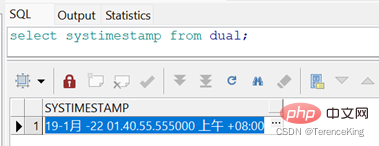
DBTIMEZONE function
This function has no input parameters and returns the database time zone. Case code:select dbtimezone from dual;
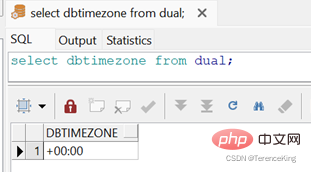 ## Add the specified month function to the date:
## Add the specified month function to the date:
This function returns the date after adding the number of months n to the specified date r. Where
r: the specified date.
n: The number of months to be added. If N is a negative number, it means the number of months to be subtracted.
Case code:
select to_char(add_months(to_date('2018-11-12', 'yyyy-mm-dd'), 1),
'yyyy-mm-dd'),
to_char(add_months(to_date('2018-10-31', 'yyyy-mm-dd'), 1),
'yyyy-mm-dd'),
to_char(add_months(to_date('2018-09-30', 'yyyy-mm-dd'), 1),
'yyyy-mm-dd')
from dual;Result: (If the specified date is the last day of the month, the returned last day of the new month is also the last day of the new month. If the new month is less than the specified month date, The valid date will be automatically recalled)
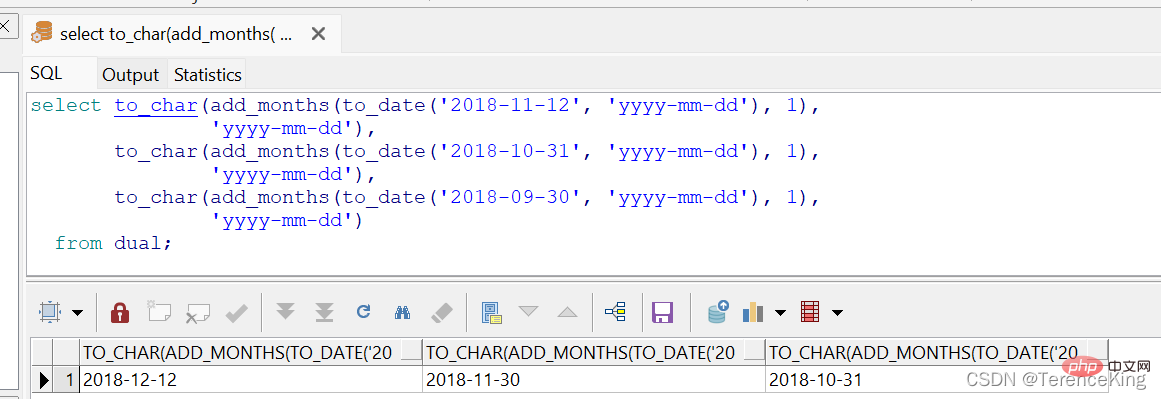 Last day of month function
Last day of month function
Returns the last day of the current month for the specified r date.
Case code:
select last_day(sysdate) from dual;
Result:
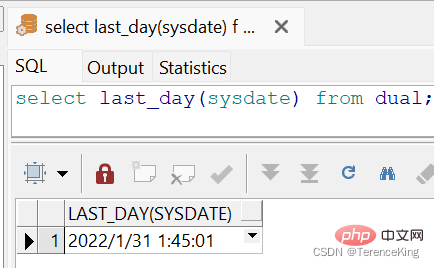 Date function one week after the specified date:
Date function one week after the specified date:
Returns the date corresponding to the r date character (c: indicating the day of the week) in the week after the specified R date.
Case code:
select next_day(to_date('2018-11-12','yyyy-mm-dd'),'星期四') from dual;Result:
 Function that returns a specific part of the specified date
Function that returns a specific part of the specified date
Returns the year, month, day, and divided date part of the specified time.
Case code:
select extract(year from timestamp '2018-11-12 15:36:01') as year, extract(month from timestamp '2018-11-12 15:36:01') as month, extract(day from timestamp '2018-11-12 15:36:01') as day, extract(minute from timestamp '2018-11-12 15:36:01') as minute, extract(second from timestamp '2018-11-12 15:36:01') as second from dual;
Result:
 Return the number of months between two dates:
Return the number of months between two dates:
This function returns the direct month of r1 date and r2 date. When r1>r2, a positive number is returned. If r1 and r2 are on the same day in different months, an integer is returned, otherwise a decimal is returned. When r1
Case code:
select months_between(to_date('2018-11-12', 'yyyy-mm-dd'),
to_date('2017-11-12', 'yyyy-mm-dd')) as zs, --整数
months_between(to_date('2018-11-12', 'yyyy-mm-dd'),
to_date('2017-10-11', 'yyyy-mm-dd')) as xs, --小数
months_between(to_date('2017-11-12', 'yyyy-mm-dd'),
to_date('2018-10-12', 'yyyy-mm-dd')) as fs --负数
from dual;Copy after login
Result:
 Date interception function
Date interception function
ROUND(r[, f]) Function
rounds the date r according to the format of f. If f is not filled in, it will be rounded to the nearest day.
Case code:
select sysdate, --当前时间
round(sysdate, 'yyyy') as year, --按年
round(sysdate, 'mm') as month, --按月
round(sysdate, 'dd') as day, --按天
round(sysdate) as mr_day, --默认不填按天
round(sysdate, 'hh24') as hour --按小时
from dual;
Copy after login
Result:
 ##TRUNC(r[,f]) function
##TRUNC(r[,f]) function
Truncate the date r in the format of f. If f is not filled in, the current date will be intercepted.
Case code:
select sysdate, --当前时间
trunc(sysdate, 'yyyy') as year, --按年
trunc(sysdate, 'mm') as month, --按月
trunc(sysdate, 'dd') as day, --按天
trunc(sysdate) as mr_day, --默认不填按天
trunc(sysdate, 'hh24') as hour --按小时
from dual;
Copy after login Result:
Recommended tutorial: " Oracle Learning Tutorial
Oracle Learning Tutorial
"The above is the detailed content of Summary and sharing of Oracle date functions. For more information, please follow other related articles on the PHP Chinese website!
Case code:
select months_between(to_date('2018-11-12', 'yyyy-mm-dd'),
to_date('2017-11-12', 'yyyy-mm-dd')) as zs, --整数
months_between(to_date('2018-11-12', 'yyyy-mm-dd'),
to_date('2017-10-11', 'yyyy-mm-dd')) as xs, --小数
months_between(to_date('2017-11-12', 'yyyy-mm-dd'),
to_date('2018-10-12', 'yyyy-mm-dd')) as fs --负数
from dual;Result:
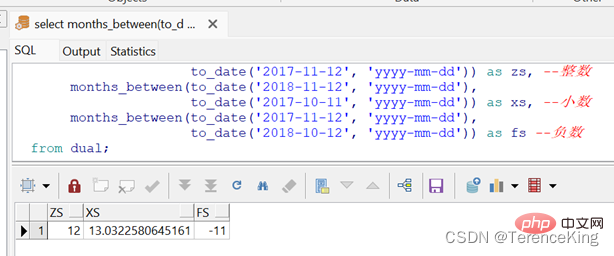 Date interception function
Date interception function
rounds the date r according to the format of f. If f is not filled in, it will be rounded to the nearest day.
Case code:
select sysdate, --当前时间 round(sysdate, 'yyyy') as year, --按年 round(sysdate, 'mm') as month, --按月 round(sysdate, 'dd') as day, --按天 round(sysdate) as mr_day, --默认不填按天 round(sysdate, 'hh24') as hour --按小时 from dual;
Result:
 ##TRUNC(r[,f]) function
##TRUNC(r[,f]) function
Truncate the date r in the format of f. If f is not filled in, the current date will be intercepted.
Case code:select sysdate, --当前时间 trunc(sysdate, 'yyyy') as year, --按年 trunc(sysdate, 'mm') as month, --按月 trunc(sysdate, 'dd') as day, --按天 trunc(sysdate) as mr_day, --默认不填按天 trunc(sysdate, 'hh24') as hour --按小时 from dual;
Recommended tutorial: "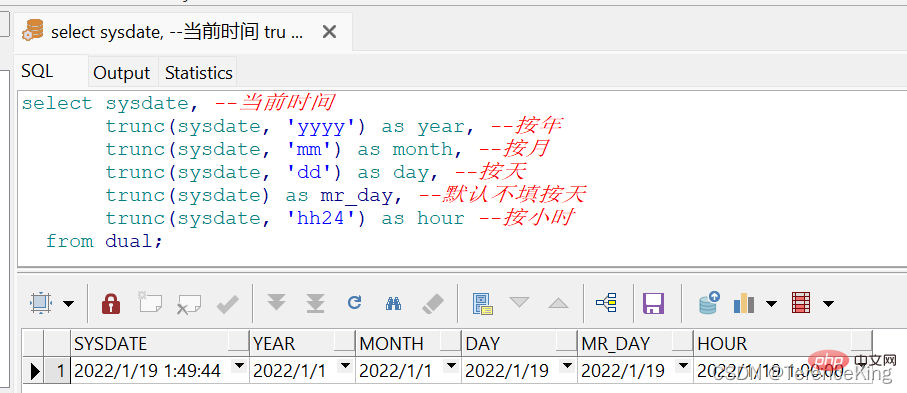 Oracle Learning Tutorial
Oracle Learning Tutorial
The above is the detailed content of Summary and sharing of Oracle date functions. For more information, please follow other related articles on the PHP Chinese website!

Hot AI Tools

Undresser.AI Undress
AI-powered app for creating realistic nude photos

AI Clothes Remover
Online AI tool for removing clothes from photos.

Undress AI Tool
Undress images for free

Clothoff.io
AI clothes remover

AI Hentai Generator
Generate AI Hentai for free.

Hot Article

Hot Tools

Notepad++7.3.1
Easy-to-use and free code editor

SublimeText3 Chinese version
Chinese version, very easy to use

Zend Studio 13.0.1
Powerful PHP integrated development environment

Dreamweaver CS6
Visual web development tools

SublimeText3 Mac version
God-level code editing software (SublimeText3)

Hot Topics
 1384
1384
 52
52
 How to check tablespace size of oracle
Apr 11, 2025 pm 08:15 PM
How to check tablespace size of oracle
Apr 11, 2025 pm 08:15 PM
To query the Oracle tablespace size, follow the following steps: Determine the tablespace name by running the query: SELECT tablespace_name FROM dba_tablespaces; Query the tablespace size by running the query: SELECT sum(bytes) AS total_size, sum(bytes_free) AS available_space, sum(bytes) - sum(bytes_free) AS used_space FROM dba_data_files WHERE tablespace_
 How to get time in oracle
Apr 11, 2025 pm 08:09 PM
How to get time in oracle
Apr 11, 2025 pm 08:09 PM
There are the following methods to get time in Oracle: CURRENT_TIMESTAMP: Returns the current system time, accurate to seconds. SYSTIMESTAMP: More accurate than CURRENT_TIMESTAMP, to nanoseconds. SYSDATE: Returns the current system date, excluding the time part. TO_CHAR(SYSDATE, 'YYY-MM-DD HH24:MI:SS'): Converts the current system date and time to a specific format. EXTRACT: Extracts a specific part from a time value, such as a year, month, or hour.
 How to encrypt oracle view
Apr 11, 2025 pm 08:30 PM
How to encrypt oracle view
Apr 11, 2025 pm 08:30 PM
Oracle View Encryption allows you to encrypt data in the view, thereby enhancing the security of sensitive information. The steps include: 1) creating the master encryption key (MEk); 2) creating an encrypted view, specifying the view and MEk to be encrypted; 3) authorizing users to access the encrypted view. How encrypted views work: When a user querys for an encrypted view, Oracle uses MEk to decrypt data, ensuring that only authorized users can access readable data.
 How to view instance name of oracle
Apr 11, 2025 pm 08:18 PM
How to view instance name of oracle
Apr 11, 2025 pm 08:18 PM
There are three ways to view instance names in Oracle: use the "sqlplus" and "select instance_name from v$instance;" commands on the command line. Use the "show instance_name;" command in SQL*Plus. Check environment variables (ORACLE_SID on Linux) through the operating system's Task Manager, Oracle Enterprise Manager, or through the operating system.
 How to uninstall Oracle installation failed
Apr 11, 2025 pm 08:24 PM
How to uninstall Oracle installation failed
Apr 11, 2025 pm 08:24 PM
Uninstall method for Oracle installation failure: Close Oracle service, delete Oracle program files and registry keys, uninstall Oracle environment variables, and restart the computer. If the uninstall fails, you can uninstall manually using the Oracle Universal Uninstall Tool.
 How to check invalid numbers of oracle
Apr 11, 2025 pm 08:27 PM
How to check invalid numbers of oracle
Apr 11, 2025 pm 08:27 PM
Oracle Invalid numeric errors may be caused by data type mismatch, numeric overflow, data conversion errors, or data corruption. Troubleshooting steps include checking data types, detecting digital overflows, checking data conversions, checking data corruption, and exploring other possible solutions such as configuring the NLS_NUMERIC_CHARACTERS parameter and enabling data verification logging.
 How to create oracle dynamic sql
Apr 12, 2025 am 06:06 AM
How to create oracle dynamic sql
Apr 12, 2025 am 06:06 AM
SQL statements can be created and executed based on runtime input by using Oracle's dynamic SQL. The steps include: preparing an empty string variable to store dynamically generated SQL statements. Use the EXECUTE IMMEDIATE or PREPARE statement to compile and execute dynamic SQL statements. Use bind variable to pass user input or other dynamic values to dynamic SQL. Use EXECUTE IMMEDIATE or EXECUTE to execute dynamic SQL statements.
 How to solve the problem of closing oracle cursor
Apr 11, 2025 pm 10:18 PM
How to solve the problem of closing oracle cursor
Apr 11, 2025 pm 10:18 PM
The method to solve the Oracle cursor closure problem includes: explicitly closing the cursor using the CLOSE statement. Declare the cursor in the FOR UPDATE clause so that it automatically closes after the scope is ended. Declare the cursor in the USING clause so that it automatically closes when the associated PL/SQL variable is closed. Use exception handling to ensure that the cursor is closed in any exception situation. Use the connection pool to automatically close the cursor. Disable automatic submission and delay cursor closing.




